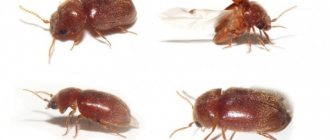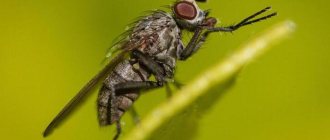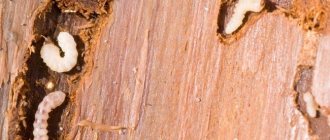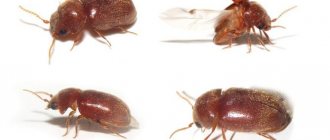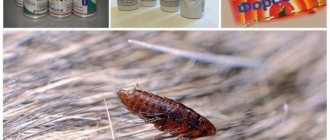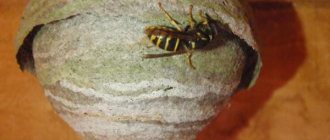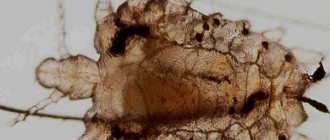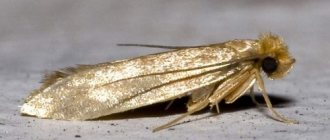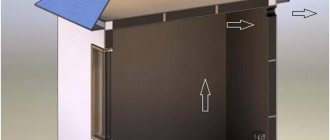Do-it-yourself woodworm control
First of all, it is necessary to determine the size of the disaster. To do this, you should carefully inspect all wooden surfaces and identify areas of damage. If the source is furniture, it is immediately removed from the home and disposed of. The most reliable way is to burn the affected objects. The passages and holes are checked using a screwdriver; if it is easily stuck to a great depth, the element will have to be replaced. If the damage is minor, then you can use improvised means. The following measures will give a good result:
- filling the passages with petroleum jelly, a mixture of naphthalene and gasoline, followed by sealing with paraffin or putty;
- heating to 60 C ° or freezing to -2 C ° or more;
- treatment with insecticide using a spray bottle.
1 fight against the borer beetle in a wooden house
2 there is a beetle grinder in a wooden house
At the initial stage of damage to wooden products by insects, you can try to solve the problem using natural remedies and methods. Naturally, it will be possible to get rid of pests only if their appearance is detected before several new generations are born, and the condition of the tree reaches a level where practically nothing can be corrected.
The simplest folk remedies to combat grinders are:
- Table salt solution. It is used to treat contaminated surfaces. The effect can only be achieved indoors.
- An aqueous solution of sodium fluoride or fluoride with a concentration of no more than 2.5%. The composition is prepared simply, use at the rate of 200 ml per m2. A regular paint brush, roller or spray gun is suitable for processing.
- A mixture of naphthalene, resin and black carbolic acid. The components are mixed in equal quantities and the wood is treated with a brush.
- Hot olive. The surface is treated with the compound only when the appearance of the wood no longer matters, and the emphasis is placed on its durability and integrity.
- A solution of turpentine and kerosene (3:1). The mixture is poured into the holes made by pests in the surface of the tree, after lubricating it with Vaseline.
- Kerosene with linseed and motor oils. Wood is processed using brushes and rollers.
When studying folk remedies and methods, you need to remember that bugs appear in furniture for a reason. They are attracted to dampness, which means it is easier to avoid infection by keeping furniture and wooden objects in dry rooms with an optimal microclimate and regular ventilation.
Protecting wood from wood-boring beetles
Before building a bathhouse, carefully examine the wood, there should be no wormholes on it, choose fumigated and dried material. Many people wonder if a log is infested with a beetle, what to do in this case? The easiest way is to send the logs for sawing and then dry them thoroughly. After this, partitions or rafters can be constructed from them. This applies to material with surface wormholes; it is better not to use logs of a thick, dirty gray color in construction at all.
When the bathhouse has already been built, the most important thing is correct and timely preventive measures:
- Ensure the building is dry, repair the roof on time;
- Regularly inspect the bathhouse for the appearance of bugs - pests - round holes, drill flour.
When the lesion has been identified, it is necessary to make repairs and treat the wood against beetles.
- If the tree is not severely damaged and there are only a few holes, you can inject a liquid insecticide into each of them.
- For numerous holes, a similar composition is applied with a brush, covering undamaged areas.
- Remember that each hole will need to be plugged.
- If necessary, the procedure can be repeated.
- Severely damaged wood will have to be cut out and replaced with new wood.
- New ones can be made and all the wooden elements of the bathhouse can be easily replaced.
- Treat the replaced parts, those elements that are always moistened, with an antiseptic - this is good protection for the wood from beetles. An antiseptic in the form of a paste is more effective and this treatment lasts for a long time.
Of course, other types of insects that do not spoil the wood can also appear in the bathhouse - ants, wood lice and others, but they do not pose a danger to the building. And their removal is a completely different story.
How to detect beetles in wood
The destruction of woodworms should begin with their detection. Let's look at the signs by which you can recognize an affected tree:
- Tortuous passages may be observed on the surface and inside the material. In the course of their activity, beetles leave drill flour, which looks like a yellowish or brown powder. As a rule, if the bark is damaged, this substance will have a light tint, and if the deep layers are damaged, the drill flour will be dark.
- From the passages drilled by woodworms, a brown liquid with a sharp sour odor is released.
- Affected and dried bark is easily separated from the tree trunk.
- Directly under a wooden structure or plant, caterpillars can be observed crawling onto another object.
The discovery of parasites in the walls of a building or in furniture indicates that it is time to immediately begin eliminating insects. If a wooden object has no particular value, it is best to burn it entirely or cut it off and burn only the affected part. But in cases where this is impossible, you should use special means to treat the tree against beetles.
What else do you need to know about wood-boring beetles?
- Parasites begin to be active with the arrival of warm weather in the spring; this period mainly occurs in May-June.
- You can infect your home with such pests yourself if you purchase lumber with larvae or pupae inside. Therefore, it is important to carefully look at the product you choose.
- We must not miss the moment to combat wood borers, otherwise the damage from their pest activity can be very significant. As soon as you notice the appearance of potholes, wrinkles, the presence of mealy powder or a brownish liquid with a sharp sour odor on wood materials, take action immediately.
- The larvae of some species can be detected quite quickly by removing part of the bark, or using modern devices.
To combat woodworms, the most effective method, but not guaranteed, is fumigation with phosphine. You can also consider the method of microwave disinfestation against beetles in the house. Only XILIX GEL can guarantee that there will be no bugs in your house for 10 years!
Longhorn beetle
This insect also happily settles in wooden houses and it can be difficult to drive it out. If fine wood dust appears in the house, and small neat holes are found in wooden surfaces, these are traces of his activity. The second name of the insect is the woodcutter beetle, which speaks for itself. Creaking and tapping in the silence of the night should be regarded as a declaration of war and an urgent need to save the house from the aggressor.
The insect is quite large, more than 11 centimeters in length, the head is decorated with long antennae, the color ranges from dark brown to black. Once inside the house, he happily takes on partitions, wooden upholstery, floor boards, window frames and load-bearing beams. The longhorned beetle in a wooden house can cause enormous harm. The means of combating it are standard; the main thing is to immediately begin treatment at the first sign of the appearance of the pest.
Interesting Facts
The insect got its name from the peculiar sound it makes. This sound is similar to the ticking of a clock. The wood grinder produces it using a special shield located on its chest, hitting it against the walls of the passage that it has gnawed.
This action occurs during the breeding season to attract females to mate.
Previously, people thought that if such sounds began to be heard in the house, then they should leave it immediately, since such ticking foreshadowed the death of one of the inhabitants. In fact, they were right, since without the necessary means to combat borer beetles, people could after some time find themselves buried alive under collapsed wooden structures. In some countries, the sound made by these beetles is called the “death clock.” And during military operations, soldiers often mistook such sounds for the ticking of an explosive mechanism and hastily left the place.
Types of grinder beetles and their characteristics
Many people don't even realize how harmful this insect is. Depending on the type of insect, the damage they cause to a person’s home can be different, but serious. In the photo you can see the borer beetle, as well as certain species of this harmful insect.
Furniture sharpener
This is an insect that grows up to 5 mm in length, which is distinguished by a dark brown body color, with golden splashes that are clearly visible on the back. It feeds on and processes any type of wood, which poses a serious danger. It is found mainly in home furniture, but in certain conditions it does not refuse the walls of a wooden house. In addition, it can ruin any product that contains cellulose. These are picture frames, books, cardboard, as well as wood products that are of interest to the pest.
It is very difficult to detect the pest, because at the slightest danger it hides and freezes for a while. The fact that wooden structures are affected by a furniture grinder can be understood by the presence of small holes in the wood, as well as yellowish dust that spills out of these holes. In these holes, after some time, the female lays eggs, from which rather voracious larvae will subsequently be born.
House grinder
This type of pest prefers damp wood rather than dry wood, so it is more often found outdoors rather than indoors. The house grinder grows up to 5-7 mm in length. In the photo below you can see what a wood-boring beetle looks like.
Common comb grinder
You can distinguish this pest from its relatives by its unique mustache. Grows to sizes 3-5 mm. If this beetle penetrates into the thickness of the wood, it will not leave it until only dust remains of the wood.
Bread grinder
This pest does not sharpen wood, but renders dry food products, such as cereals, grains, pasta, including dried fruits, unusable. In this regard, we can safely say that the bread grinder poses a serious threat to humans. It can easily leave a person without food if their condition is not controlled.
Black house beetle
This type of pest prefers dry coniferous wood, so it cannot be found in living trees. The female lays eggs under the bark of dried or cut down trees in the warm season. Therefore, the black longhorned beetle enters a person’s home along with firewood or building materials that have not undergone special treatment.
Description of the insect
Four types of beetles live in heated rooms: furniture beetles, house beetles, grain beetles, barbel beetles, and, less commonly, bark beetles.
Characteristic features of grinder beetles:
- an elongated body (from 3 to 10 mm) of a cylindrical shape with a relatively small head;
- hard wings, covered with a hard chitinous shell with hairs;
- three pairs of five-jointed legs;
- antennae of different lengths;
- color in brownish tones with reddish, greenish-yellow shades.
Adult beetles crawl out of their nests only during the breeding season.
The main function of an adult beetle is mating and laying eggs by females. They do not live long, from one to three weeks. One female lays from 40 to 200 eggs per clutch, depending on the species. The main damage to wood is caused by larvae. From the first minute of their appearance, they begin to actively eat the tree. It takes from one to three years before pupation. During the day, the larva makes passages up to 3 mm in the tree.
Nutrition
The larvae of beetles mainly feed on cellulose in wood and paper. One of the types, bread, is found in food products: dry bread, cereals, dried fruits, pasta. Some species prefer dry wood, others wet. The population of wood grinder beetles causes significant damage to structures and wood products, literally eating it away from the inside, turning it into dust.
Life cycle and reproduction
The danger of grinder beetles is that they have a long biological life cycle, up to three years. The adult individual (imago) of the beetle grinder can be seen only in the warm season in May-June, when it gets out of the nest and mates. Caterpillars inside wood can live from three years to 15–17 years. Periodically, if the temperature fluctuates downwards, it goes into suspended animation.
Cycle:
- Eggs. The female beetle grinder lays eggs in cracks, crevices, and in nests that the female makes. They are whitish or transparent in appearance, 1–1.5 mm long. The clutch of eggs contains symbiotic microorganisms, they help the larvae digest cellulose.
- Larvae. They begin to appear at about 7–12 days. The shape resembles a semi-rolled white worm (3–4 mm). Most have several pairs of short, prehensile legs that help them move along the aisles.
- Pupa of a beetle grinder. An adult individual is formed from it in 2–3 years. Before transformation, the larva stops eating for several days. The pupa has enough accumulated nutrients.
The optimal temperature for reproduction is +28 – +30°C. If a similar temperature regime is maintained in the house, then certain types of grinder beetles can crawl out and reproduce all year round.
This is interesting. Getting rid of woodworm is difficult. All individuals of the biological chain spend most of their time inside the structures of a log house or hut.
Borer beetles can also be detected by the characteristic sound inside a wooden structure. Before mating, the male lightly hits his head against the walls of the passage. This is a conditioned signal for the female, reminiscent of the ticking of a clock mechanism.
Types and features
Not everyone knows how dangerous woodworms are. The amount of damage caused to a home depends on the type of wood beetle. Below is a photo of the beetle grinder and the most common types of this insect.
Furniture sharpener
Larvae of the furniture borer
The furniture borer is a small, up to 5 mm, woodborer of a dark brown color with golden spots on the back. It is dangerous for all types of wood. The insect lives mainly in dry household furniture, but can also feed on the walls of wooden houses. In addition, the pest is capable of attacking any objects based on cellulose (picture frames, book pages, and the like).
It is difficult to detect grinders, as they are very shy and hide in the darkest, hard-to-reach places. Their presence in furniture can only be guessed by the holes they have eaten, from which the remains of wood eaten by the beetles spill out from time to time. After some time, the females lay eggs in the existing holes, from which a new generation of pests will emerge.
House grinder
This woodborer differs from its fellows in that it feeds exclusively on raw wood. Therefore, the pest can often be found on the outside of wooden structures. The size of the insect does not exceed 5-7 mm in length. Below is a photo of a wood beetle.
Common comb grinder
Common comb grinder
A distinctive feature of this tree-gnawer is its unique mustache, which is why it got its nickname. The length of its body varies from 3 to 5 mm. It is enough for a beetle to penetrate into the thickness of the wood, and it will not leave this habitat until it is completely destroyed.
Bread grinder
Bread grinder
This grinder beetle differs from its relatives in its selectivity to food. The favorite treat of its larvae is not wood, but dry food: cereals, grains, pasta and even dried fruits. Therefore, the bread grinder is no less dangerous a pest than the previous species.
Black house beetle
Black house beetle
The barbel or woodcutter prefers to feed on coniferous wood. This woodworm likes to live in dry and warm places. Females lay eggs under the bark of coniferous trees in the warm season. Another interesting fact is that this wood-boring beetle does not live in living trees, as it does not like moisture. The pest prefers to settle in harvested coniferous wood or objects made from coniferous wood.
Grinder beetles: what are they?
There are many species of wood-boring beetles in nature, but only a few species can be found at home. These include:
- furniture;
- brownie;
- combed;
- bread
An ordinary furniture woodboring beetle with a body length of 2 to 5 mm, under favorable conditions, is capable of breeding several generations of new offspring in just one year. The insect can be identified by its dark brown color and stripes of dots on the surface of the elytra. Insect larvae reach 6 mm in length. They develop from eggs laid by the female in the most inaccessible dark areas of the furniture. The holes left by the beetle do not exceed 1-2 mm in diameter.
The house tree beetle is identified by its black-brown color with golden dots on its back. The insect reaches 3 mm in length at maturity. The beetle larvae are twice its size. Just like the furniture woodborer, the female house beetle lays eggs in the crevices of mostly coniferous furniture in places with high humidity levels.
The comb grinder reaches 5 mm in length. It feeds mainly on deciduous trees, develops inside the tree, from where it destroys it almost completely, after which it leaves the tree to search for a new source of food.
The bread borer beetle (the photo below will help you not to be mistaken) prefers dry food products and does not disdain food of plant origin.
Separately, it is worth highlighting beetles that are representatives of other families, for example, longhorned beetles and bark beetles. The larvae of the former reach 35 mm in size and gnaw through the surface of wood as close to the surface as possible.
In the photo - a bread grinder
How to get rid of the borer beetle
Effective methods have been developed to get rid of borer beetles in a timely manner. For this purpose:
- Toxic substances.
- Folk methods of struggle.
- Wood is impregnated with various liquids and mixtures.
- The wood is subjected to thermal action.
- Remove the affected areas of wooden structures.
- Smoke bombs and fumigators are used.
- They use microwave devices to irradiate problem areas.
- Use the services of special services.
Insecticides
When wooden structures are heavily damaged by the borer beetle, it is better to use insecticidal preparations. With the help of toxic drugs, it is possible to get rid of both adult individuals and larvae, which cause the greatest damage. But there is one drawback, which requires the use of personal protective equipment, such as rubber gloves, goggles, a respirator and thick clothing.
Insecticidal preparations, which have a high degree of toxicity, have a detrimental effect on pests from the first minutes of use, but they are unsafe for both humans and domestic animals. Therefore, you will have to evacuate all family members and pets from the premises for the time specified in the instructions for use of the drug. Similar control agents are sold in hardware stores.
Microwave processing
This method of control is based on the fact that the affected areas, under the influence of microwave radiation, are heated to a temperature that has a detrimental effect on the beetle and its larvae. The advantage of the method is that a person does not have to leave his home, just like a pet.
Destruction of the borer beetle in the Vitoslavlitsy Museum
Watch this video on YouTube
Special impregnations
The use of liquid to impregnate wood is relevant only if it is necessary to protect unaffected wood. This method is not suitable for combating wood-boring beetles, since it will not give the required result. For additional protection, wooden structures are plastered, which gives a 100 percent guarantee that grinders will not appear in them.
Fighting with high and low temperatures
You can fight grinders not only with high temperature, but also with low temperature. This method is called freezing. To effectively combat the pest, it is necessary to keep the affected areas for 2 days at a temperature below minus 2 degrees or by heating individual areas to a temperature above 50 degrees. This can only be achieved in special chambers, therefore, to combat a pest that has attacked a person’s home, these methods are ineffective, since they are impossible to implement in practice.
Fumigators
This control option has a significant effect, since pests die from phosphine gas. Therefore, the correct use of this gas will quickly get rid of beetles and their larvae.
GRINDER BEETLE AT HOME - REMOVAL AND PREVENTION
Watch this video on YouTube
Removing infected areas
This method of control is effective in the early stages of wood damage, since it is possible to replace individual fragments of a wooden structure. In fact, despite the simplicity of the method, it can be quite expensive.
Folk remedies
Folk remedies are not only effective, but also safe, and therefore suitable for controlling pests in human homes. If you take petroleum jelly into a syringe and inject it into the holes, and then close the holes with paraffin, wax or window putty, you can count on the fact that the pest will stop damaging the wood.
If you take and prepare a mixture of turpentine (3 hours), kerosene (1 hour) and naphthalene (8 g), as well as gasoline (90 g), then this mixture will help in the fight against the pest. This mixture is applied to infected areas of wood, but you need to be careful, since the mixture is quite flammable and instead of fighting insects you will have to fight the fire.
To prevent wood beetles from penetrating into wood products, it is enough to soak them in a saline solution. An infusion of vinegar and chopped garlic gives the same effect. If the surface of the structure is painted or plastered, this will also protect the wood from the penetration of borer beetles.
Professional processing
Often, in conditions of massive insect infestation of wooden structures, it is necessary to resort to the help of special services that have more advanced methods of pest control, especially since they have a full range of tools for this.
Cold fog treatment for the borer beetle
Watch this video on YouTube
There is a dangerous “neighbor” in the house: how to identify it and what to do?
Identification of a pest in an orchard, in wooden furniture or walls is a signal that you need to immediately begin to fight the woodworm. Below is a list of characteristic signs of a home or garden being infested with a borer:
- On the wood you can see winding, numerous holes that the woodworm eats out.
- In the process of “turning” the transition beetle, a powder is formed that resembles flour in appearance. If only the bark is affected, the powdery substance is yellow in color. Damage to the deep layers of wood is accompanied by the release of brown flour.
- A brown liquid substance emerges from the canals gnawed by the woodworm. It has a pungent, sour smell.
- Dry bark damaged by a beetle can be easily separated from the surface of a wooden trunk.
- Under bark beetle-infested plants or wooden buildings, you can find larvae and caterpillars that migrate to the following objects.
Interesting! Infestation of timber can be detected using a special electronic stethoscope. The device records the sounds that males use to attract females.
If the affected item is not of particular value, it should be burned entirely or separated and burned only the parts affected by the pest. When something absolutely must be preserved, they resort to conservative methods of struggle. Traditional recipes and chemicals are used, to which woodworms are susceptible. How to get rid of a small pest using each method? Let's look at it in order.
Destroying parasites - folk recipes
Woodworms live at home from 5 to 7 years, constantly causing damage. In the early stages, infection is difficult to detect. Often people notice a pest only when it has significantly expanded its population and caused noticeable damage to wooden objects.
Important! If you can find the grinder right away, you can use effective folk recipes.
The following will help in the fight against woodworm:
- Table salt. Prepare a saline solution. Apply it to the damaged surface in any way (spraying, wiping, pouring, etc.).
- Turpentine + kerosene. Make a mixture of two substances in a 3:1 ratio. Give the substance homogeneity. The desired area is first covered with a layer of Vaseline. Then the woodworm passages are filled with the prepared composition. The treated surface is coated with paraffin.
- Linseed oil. Apply to the surface using a brush or construction roller.
The recipe components are accessible and simple. They do not pose a threat to human health, but have a detrimental effect on the pest.
Insecticides against the borer
It is difficult to remove woodworms if they have spread en masse using folk remedies. In such cases, you have to resort to “heavy artillery” - the use of aggressive chemicals. Modern insecticides are highly effective in controlling woodworms.
Attention! Liquid preparations work better - they completely saturate the structure of the material being treated and expel the pest from it.
What should you consider if you decide to kill a beetle with chemicals?
Nature of processing. There are two categories of insecticides used in the fight against woodworm:
- drugs with residual effects - they poison and lure beetles out of ambushes. Low toxicity for humans (after use you can return to the treated house almost immediately);
- acute poisons are the most effective, very toxic. They are capable of destroying woodworms instantly. Residents can enter the premises no earlier than several hours (and sometimes several days) after the procedure.
When applying insecticides, special attention should be paid to the inner surface of furniture and hard-to-reach areas of wooden structures. The woodworm repellent must penetrate deep into the pores of the material.
It is often necessary to drill holes in affected logs to pour insecticide into them.
After introducing the solution, the surface must be treated with a sealant to enhance the effect of the drug inside the wooden object.
Woodworm repellent. Insecticides that can quickly destroy small pests are popular. They impregnate the deep layers of wood and guarantee long-lasting protection against woodworms:
- "Empire-20"
- "The Tree Doctor"
- "Anti-bug."
It is necessary to study the instructions for the purchased product. When working with it, precautions are taken and personal protective equipment is used.
The main types of wood beetles and the harm they cause
In a private house, be it wooden or stone, you can often find a variety of insects. Therefore, in order not to let the situation get worse, you need to know the enemy by sight.
Bark beetle
Bark beetles are the collective name for about 750 species of beetles. In the wild, they serve as forest orderlies, ridding it of old and diseased trees. And in wooden houses, these half-centimeter beetles eat everything they can reach. The most common of them are the pine beetle, furniture grinder, typograph beetle and sapwood.
But the odorous wood borer, although similar in name to a household pest, is actually not one of them. This moth also eats wood, but only on living fruit trees, so luring it into the house is unrealistic.
These brown or black bugs enter the home along with contaminated building materials. Each species prefers certain types of wood, but “in the absence of fish,” everything is used.
Grinder beetle
Black and brown beetles reach 1 cm in length and move mainly at night. They are very shy and hide from people, but their presence in the house is revealed by a characteristic ticking sound.
In the old days, grinders were called “the clock of death,” because a few years after the sound appeared, the house collapsed, often burying all the inhabitants under its walls.
There are bread, brownie, comb and furniture grinders. They affect furniture, books, food, spices, herbariums, coniferous and deciduous trees.
Longhorn beetle
The black beetle with a green or blue tint can be distinguished by its characteristic mustache, which is almost three times longer than the body. The beetle itself reaches 3.5 cm in length, and its larvae can live up to 15 years, making kilometer-long passages in wood. They try to settle in attics or under the roof; females lay up to 400 eggs at a time. They appear in the house with raw material even at the construction stage. There have been cases when a colony of longhorned beetles rendered a house uninhabitable before the rightful owners moved into it.
Regardless of the species, the beetles themselves are not dangerous to the home - it is the woodworm larvae that eat the wood, and the adult individuals only increase their numbers.
The development of all woodworms follows the same pattern, only the duration of the maturation periods differs:
The female lays eggs in holes or crevices in wood. The eggs hatch into larvae that feed on wood, making passages in it. After two weeks, the larvae move to the surface of the tree and pupate. After three weeks, the pupa turns into an adult beetle and flies out for further reproduction.
Although the main peak of reproduction for all wood-boring beetles occurs in the summer, in heated, frost-free houses they are able to breed throughout the year. In this case, a colony of beetles will take three years to turn the supporting structures into dust.
Wood-boring beetle: description
The pest is dark brown or black in color and is one of the representatives of the grinder beetles. Beetles are not large in size: only a few millimeters. You can't tell by their appearance that they can cause significant damage to wooden plantings or wooden structures.
They spend most of their life in the thickness of wood, actively destroying it. They come out after they turn into adult beetles. Adults are busy laying eggs. To do this, they find a suitable tree or wooden structure, gnaw a hole up to 6 cm deep, and then lay up to 80 eggs. After some time, larvae emerge from the eggs, which are busy constantly sharpening the wood, turning it into wood flour. They can stay inside a tree for up to 15 years, gnawing up to 40 km of passages during this time. As a rule, the larvae damage up to 99% of wooden plantations and other structures.
Recommendations for wood use
You must always remember that it is very difficult to fight wood-boring beetles, so it is necessary to take measures in advance to keep wooden structures intact. There are a number of recommendations that can significantly extend the service life of wooden structures. For example:
- At least once a year, inspect wooden structures for the presence of wood-boring beetles and their larvae.
- Build buildings only from dry, treated wood.
- If this is not possible, then wooden structures can be processed independently. For such purposes, it is better to use products with prolonged action.
- All wooden structures should be treated, including window frames, doors, floors, roof frames, etc.
- If infected wooden structures are found during operation, it is better to replace them and burn the old ones.
The wood-boring beetle poses a serious threat to wooden structures. The thing is that he spends the main part of his life in the thickness of the wood, rendering it unusable. In order for wooden structures to last as long as possible, they need to be treated with special compounds, after which their condition must be monitored every year.
Biology of grinders
Wood borers are a very wide group of insects. Their similarity is that, through the action of special enzymes, they are able to break down cellulose, and therefore are able to feed on wood. In addition to wood, some woodworms feed on grains, paper and similar rough foods.
The size of insects can range from one to ten millimeters, depending on their type. It is not the adults who cause the greatest harm, but the voracious larvae of wood beetles. Biologists claim that the grinders themselves account for only one percent of what is eaten, the rest is eaten by their numerous offspring.
External signs of an adult and larva
The size of the pest varies from 1 to 10 mm, which is determined by its belonging to a particular species. The antennae are comb-shaped, the body color is brown. More often there are individuals whose body length is 5 mm. The beetle is not capable of biting, and it is the larvae that cause damage to furniture. They live inside wooden structures, leaving behind many passages. The task of adults is the process of reproduction and laying eggs.
An adult beetle. The antennae are comb-shaped, the body color is brown, the body length is 5 mm.
You can find several types of grinders in your home:
- Bread
- Brownie
- Woody
- Furniture.
Eggs are laid directly in wooden structures and any dead wood. Here, offspring emerge from the shells, which allows you to immediately begin destroying the material. Externally, the larvae look normal: white worms with a dark brown head. Thanks to their hard jaws, offspring can quickly destroy a piece of furniture if left undisturbed.
The incubation period lasts only 2 weeks, but the development of larvae takes from a year to several years. Then comes a short period of pupation (lasts 3 weeks), after which an adult appears.
Prevention of woodworm occurrence
Preventive measures against the borer beetle are an essential element of protection. These include:
- clearing a tree of bark;
- visual inspection of the material;
- drying wood in special chambers in the sun.
Treatment of structures with insecticides (such as “Senezh”, “Pinotex”), special impregnations, stains, opening with varnish is an essential element of wood protection.
Borer beetles are dangerous pests. They spend most of their biological cycle inside a wooden structure, so they are difficult to immediately detect. Despite the insidiousness of the pest, there are many effective means to overcome the pest.
Why is an insect dangerous?
The presence of tree beetles in an apartment initially poses a danger to human property. The situation is aggravated if you are dealing with a furniture sharpener. It causes irreparable harm to unvarnished and untreated furniture, which also had a high cost for the owners.
The appearance of grinders in the house will lead to the following serious problems:
- complete damage to furniture: if a beetle has settled in one piece, it will certainly spread to other items;
- a complete violation of the interior - damaged sets will stand out from the overall design;
- loss of furniture functionality - furniture eaten by parasites becomes rotten and can no longer perform the functions for which it was intended;
- discomfort in a person’s daily life – beetles constantly flying out of holes cause a lot of inconvenience.
You can notice the borer in the spring season - these insects accumulate in window frames so that at the first opportunity they can get into the furniture and get to work. Since the period of their activity is the warm season, immediately after the end of winter they can be observed in some houses. It is worth noting that the risk of a furniture grinder increases if the frame of the house is made of wood.
Parasites appear in poorly heated rooms, where there is increased dampness, and ventilation conditions are also compromised. The beetle can live and reproduce only in stuffy temperatures, so as a preventive measure it is necessary to ventilate the room more often, maintain a dry climate and ensure good lighting of the room.
Furniture damaged by borers
What does a grinder beetle and its larva look like?
The furniture grinder is a small dark brown beetle whose body length does not exceed 4–5 mm. In the photo you see an adult.
The beetle belongs to the order Coleoptera. By itself, it is harmless and cannot bite. Lays eggs. The real pest is the larva, which, after emerging from the egg, feeds exclusively on wood, making long tunnels in it. If there are a lot of larvae, then they can turn the furniture in the apartment (in the kitchen this will be most noticeable) or the wooden floor in the room into dust literally in one season.
The photo shows the larva of a furniture (house) grinder.
It is almost impossible to notice a bug in a house or apartment, and the larvae are generally invisible, since they live in the depths of the furniture. But there are certain signs that indicate the presence of furniture sharpeners. This:
- very quiet rhythmic tapping inside the walls of the furniture. The sound is produced in portions: six to ten beats, then a short break and repetition of the session. The tapping sounds are quite distinct. The sound is reminiscent of a pendulum clock, but with its own unique rhythm;
- holes on wooden surfaces. The presence of a house grinder in an apartment or private house will be indicated by small diameter holes appearing on wood objects.
In the photo you see a beam with numerous holes through which adult bugs flew out. The appearance at the surface is quite specific and does not raise doubts about the presence of bark beetles.
Sometimes there are no traces of holes on wooden surfaces yet, and then only the characteristic sounds of grinder beetles will indicate the presence of pests.
How do house (house) and furniture grinder beetles overwinter? They burrow into the soil below the freezing level.
Use of folk and chemical remedies
There are several popular ways to get rid of the bread grinder in the kitchen. They are quite effective, and, unlike chemicals, they are absolutely safe for the health of people and animals:
- Use pyrethrum powder, which can be purchased at a pharmacy. It needs to be dissolved in a small amount of water and the resulting solution should be used to wipe down the kitchen cabinets every week until the insects are completely gone.
- Borax is often used to control many types of pests. To use it to get rid of the bread grinder in your apartment, you should make balls. To do this, you need to mix borax with pre-crushed millet and powdered sugar. The prepared balls are laid out in the corners of the kitchen furniture.
- Borax combined with yeast. This is a very simple but quite effective method of combating the grinder. Borax, yeast and sugar should be ground well and, scattered on cardboard, placed in places where insects are found.
The use of chemicals to combat this insect is highly undesirable. The main reason is that these beetles live mainly in food - after using toxic substances, they can no longer be used as food.
If you spray the cabinet with the packages tightly closed, there will be no effect, since the chemical will not be able to penetrate inside the box or bag. In addition, any chemical negatively affects the person carrying out the treatment.
The use of chemicals is justified only when the question arises of how to get rid of the bread borer beetle in books. If pests have occupied a bookshelf, then you can fight them by chemically treating the shelves and cabinets.
If books are severely damaged, they must be disposed of. In addition to using “chemistry”, a book can be saved by leaving it in the cold for a day (at a temperature no higher than -15°C).
House borer (Anobium pretinax)
It is found almost everywhere in the European part of the Russian Federation, in the Caucasus and Siberia - up to Irkutsk. It is much larger than a furniture sharpener, its length is 4.5-5 millimeters. The color is brown, on the front back at both rear corners there is one golden-yellow spot.
Flight in May-June. The female lays eggs in crevices of exposed wood or in old passages, about 6 eggs separately. The emerging larva is very similar to the furniture grinder larva, but larger. The stroke width is about 3 and the length is about 10 millimeters. Before pupation, the larva approaches the surface of the tree almost at a right angle and leaves only a very thin film ungnawed.
At this point the passage turns into a pupal cradle. It is lined with brown flour mixed with feces, and separated from the rest by a cork of the same content. A young beetle emerges from the pupa and gnaws a flight hole with a diameter of 2.5-3 millimeters. Depending on external conditions, generation lasts from a year to 2-3 years.
The house borer inhabits wood mainly in places where it is exposed to winter frosts. In stone residential buildings - in the attic in the beams (first at the ends of the beams lying in the nests of the external walls, then in those parts of them that are periodically wetted from leaking roofs), in the selection, flooring and rafter legs, in the attic partitions.
The house grinder does not colonize fresh wood, but wood that has lain in buildings for several years. Acceptable humidity for it is from 11 to 18%. Under favorable conditions, its development period lasts a year.
This is the most common and dangerous beetle among house beetles. It has a flat black body 2-3 centimeters long, covered with delicate whitish hairs. The beetles fly in July–August. The female lays up to 50 eggs up to 2 millimeters in size in cracks and crevices of wood. Their shape is elongated, their color is yellowish-white.
It is very important to promptly detect the appearance of destroyers in the house. To do this, it is necessary to carefully examine the wooden parts of structures that do not have access to light, attic spaces, and the most humidified parts of buildings
Insects can be detected by round holes in the wood, from which fine brown flour pours out abundantly.
It is not always possible to determine the type of pest based on the nature of wood damage. Therefore, you definitely need to look for larvae or adult beetles. Certain types of grinders are similar to each other. It is necessary to determine exactly what species the detected pests belong to.
Types of wood-boring beetles
There are several varieties of insects that can be classified as wood-boring beetles. Let's take a closer look at what these pests are:
- The brown beetle, also called the black beetle or the woodcutter, is an insect that most often attacks coniferous trees. The brown barbel loves dryness and warmth, so its females begin to actively reproduce in the summer, laying larvae under the bark of coniferous trees. It is worth noting that it is almost impossible to find these beetles in living trees, since they do not tolerate moisture. But if you have prepared boards or have any items on your farm made from conifers, this parasite can harm them. It is not difficult to recognize these insects; in the course of their life, they leave winding passages in the wood. Affected objects may be covered with a white powdery coating. The brownie bark most likes coniferous bark, so when harvesting wood, you should carefully remove even small fragments of bark from the trunks.
- The false bark beetle, also called the hooded beetle, is another type of wood-boring beetle. These insects often live in latitudes with warm climates, and they can infect almost any wood, easily coping with even durable oak boards. As a rule, false bark beetles gnaw passages along the fibers of the material, making the wood fragile. Such pests can most often be found on support poles, fences, and wells.
- Weevil beetles are dangerous because they attack not only dead wood, but also living trees. Such insects prefer a moist environment, so traces of their destruction can be observed among firewood lying in damp firewood or directly in the open air. To avoid damage to the walls of wooden houses, bathhouses or sheds, try to store firewood as far as possible from such buildings. Fruit trees should also be protected from the weevil beetle, otherwise you may lose both young seedlings and adult plants.
- The borer beetle earns its name due to the characteristic marks it leaves in wood. The diameter of its strokes is quite significant and is approximately 1-2 mm. An interesting fact is that the food for such a pest is not the wood itself, but the mycelium that grows in the canals it makes. The favorite species of the parasite are oak and walnut. Fortunately, these trees are not used as the main building material in the construction of log houses, but the first crown of buildings, as a rule, is made from oak trunks. Among other things, the borer beetle often infects coniferous trees, and especially their bark. If conifers grow on the site, they must be periodically treated with the necessary insecticides.
- One of the most common types of pests is the grinder beetle. You can meet this wood-boring beetle both at home, for example, in wooden furniture, and in the walls of street buildings. This parasite even eats the wood of living plants, making it a dangerous garden pest. Female borer beetles lay eggs in dead or dying wood; the insect loves high humidity and actively breeds in the northern walls of log houses. It is almost impossible to notice affected boards or trunks, since the beetles eat away their central part, leaving the outer shell intact. Experts can determine the presence of borer in wood using electronic stethoscopes. The device picks up sound signals that males give to females in order to attract their attention for procreation.
How to find out about the presence of unpleasant insects?
So, let's figure out how to determine whether there are tree beetles in the house (photos of pests are presented in this material):
The first thing you need to pay attention to is the presence of holes. When insects appear on the furniture, small round holes appear, under which lies “drill flour”. If the larvae have climbed far, the entire entrance will be filled with rot.
In this case, a caked mass, or “wormhole,” appears on the wood surface. The darkened sides of the furniture need special attention: it is in these places that holes left by bugs can most often be found.
To find out how seriously the wood is damaged, just pierce it with a screwdriver. If the wood remains hard, you can get by with special treatment. Antiseptic agents, aerosols or pastes will help preserve the wood. Today, the most popular drugs are Antizhuk, Wood Healer, Basilit and Empire-20. Each of these products is applied in an even, not too thick layer so that it does not run off the surface. You can also use motor linseed oil or kerosene. If the screwdriver easily pierces the wood, then it is unlikely that it will be possible to save the damaged areas. And in the future, try not to forget that the fight against wood beetles is a necessary measure to protect wooden structures.
As a rule, insect pests live in passages that they themselves have carved into the tree. During the breeding season, they begin to fly actively and can crawl out onto window sills.
According to reviews and recommendations of experts in the field of wooden house construction, today the best remedy for wood beetles is products. Neomid Antizhuk is considered the most powerful drug against tree beetles.
Destruction methods
From time immemorial, grinders have been neighbors with people, so methods of combating them have been known for a long time. There are many ways to kill beetles, but they all have a rather weak effect. The reason for this lies in the specific habitat of insects - it is impossible to penetrate their passages and ensure direct contact of insecticides with beetles and larvae.
For garden plants, the grinder is not so dangerous, since in winter they undergo natural treatment at low temperatures for a long time. It is more difficult if insects appear in residential or commercial premises.
Traditional methods
Let's consider several traditional methods of destroying the grinder:
- Vaseline oil . This composition is pipetted and syringed into the passages made by the grinder. At the end of the procedure, the holes are sealed with wax. The method is safe, since the oil is odorless and completely harmless, it does not burn and does not damage healthy wood. The procedure is repeated after 2 weeks.
- A mixture of kerosene and turpentine in a ratio of 3:1 . The application method is the same, pour it into the passages with a pipette. In this case, a specific smell appears in the premises, which lasts for quite a long time.
- A mixture of naphthalene (8 g) with benzene (80 ml) . In the same way, the composition is poured into the holes. If this is not possible, apply it to the surface with a brush. The smell from the product is very strong and does not dissipate for a long time.
- A mixture of carbolic acid, naphthalene and resin . They are combined in equal parts, mixed thoroughly and filled with the resulting composition into all the holes that could be found.
- Temperature treatment of problematic products . Temperatures above +60° and below -2° are destructive for larvae and insects. Accordingly, the products are taken out into the cold and kept for at least a day (several days, a week or more is recommended), or treated with hot steam. The second option is ineffective, since wood is an excellent heat insulator. Many insects located inside the passages easily tolerate the treatment. Cooling is more productive, but not all items can be processed in this way.
Traditional methods of fighting the grinder are quite effective, but have a lot of disadvantages. Most formulations have a strong, persistent odor that lasts for a long time. if the treatment was carried out in residential premises, the harmful effects will affect not only insects, but also people.
Use of insecticides and chemical compounds
The most effective methods of influencing the grinder are chemicals or special preparations - insecticides. However, they are used only in case of extensive damage to critical structural elements of the house, walls or ceilings. Chemical compounds are dangerous and must be used with caution and care.
The most effective means include:
. It is poured into the holes, which are previously cleaned of drill flour.
Copper sulfate solution- Use of aerosols . There are many similar compounds on sale (for example, Prima 71), which can quickly treat even hard-to-reach areas.
- Fumigation . This is a procedure in which an object is placed in a plastic cocoon (using a bag or wrapped in film), and a large amount of dichlorvos is sprinkled inside.
- Microwave radiation . This is a modern method in which the wood is heated from the inside, destroying the larvae. Treatment is carried out sequentially, bypassing all affected areas.
- Use of insecticides . These compounds are very effective, but for application it is necessary to use special tools and first remove the drill flour. There is a technology for continuous douching, when holes are drilled (about 1 mm) and the composition is injected into them with a syringe with a thin needle. You have to drill often, so the measure is considered forced, an extreme measure.
The success of the procedure depends largely on the precise choice of chemical or composition. Most users are not very good at this. Therefore, the best solution would be to contact a specialized company, where they will help you choose the right composition and carry out the procedure for exterminating insects.
The most effective insecticides recommended by experts are:
This is a group of antiseptics consisting of 5 drugs of varying intensity. 1 grade is used for preventive treatment of wood and garden plants, the rest are used as needed;
A biocidal preparation that is applied by brush, roller or spray. Suitable for treating premises and garden plants;
Used as a preventive and therapeutic agent for affected wood.
A powerful insecticide based on chlorpyrifos;
Prevention measures
To avoid encountering uninvited guests, do this:
- varnished or unpainted surfaces are wiped with a mixture of turpentine, wax and creolin (10:5:3), the solid components are melted;
- check all lumber, including ornamental pieces, frames, old furniture;
- plaster the walls with the addition of antiseptic components;
- Grinders love moisture, so they organize good ventilation and airing in the bathhouse and bathrooms.
If beetles are detected, all pieces of furniture and structure are checked. Taking timely measures will prevent the destruction of wood. But it is better to throw away severely damaged furniture. In particularly difficult cases, exterminators are called.
How to get rid of wood-boring beetles
It is not at all easy to combat this wood pest, since it does not crawl out, but is constantly located in the thickness of the wooden structure. Therefore, its presence is sometimes discovered quite late, when the structures are already deteriorating. If the shashel was discovered at an early stage, then the fight against it must be started immediately, otherwise only memories will remain from the wooden structure.
There are several effective ways to get rid of pests of this type. For example:
- Using insecticides.
- By fumigation and fogation (fumigation).
- Treat the wood with dry steam.
- Destroy the pest with microwave radiation.
- Use folk remedies.
wood borer beetle how to get rid of Kirov
Watch this video on YouTube
Chemical insecticides - antiseptics
Chemicals in the form of emulsions or aerosols are suitable to combat shawl. Other forms of release will be ineffective because they will not be able to penetrate the thickness of the wood. Depending on the principle of action, insecticides are:
- Instant action, when insects die immediately.
- Residual action, when the product penetrates the wood, and insects die gradually as the product penetrates.
Therefore, residual chemicals are considered the most effective. Wood is impregnated with such substances, especially hard-to-reach places. Such substances are not highly toxic and odorless. Hard-to-reach places are treated with insect repellent sprays. It is most effective if you introduce the substance into the drilled holes every 5 cm. The rows of holes are located 1 meter apart from each other. The product can be poured or injected into the holes using a syringe and a thin tube. After such operations, all holes are filled with sealant. When processing vertically located structures, it is better to drill holes at an angle so that the product does not flow out of them.
How a wood-boring beetle appeared in the house.
It all started with the fact that I heard some kind of grinding noise behind the drywall, in the wooden partition wall of the house. It was not clear whether it was a mouse or someone else. The sound is rather weak for mouse fuss, but I couldn’t think of anything else. A year later, the grinding noise was heard from several places. I began to wonder what made such a sound. It turns out that the wood-boring beetle can thrive in dry wood. I remembered when I was sawing timber for a partition, I saw strange cells in the wood, then I didn’t attach any importance to it, but I should have. There was a wood-boring beetle in that timber, which I used to infect the wooden structures of the house. .
I naively thought that the beetle would scratch itself, get drunk and die. And he, the infection, before “throwing back his hooves” left behind dozens of the same. The problem was aggravated by the fact that I used wood that was not completely cleared of bark and all of it, hidden under drywall, is favorable for woodworm reproduction. After 13 years, the situation became critical; the beetle, having made a hole in the casing, climbed through the partition into our bedroom.
.
.
. In the attic, in the ceiling of the floors, here and there the creaking of beetles eating wood could be heard. The picture was developing in such a way that if nothing was done, then in 5 years the ceiling would fall on my head. .
